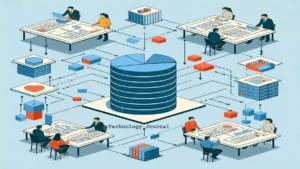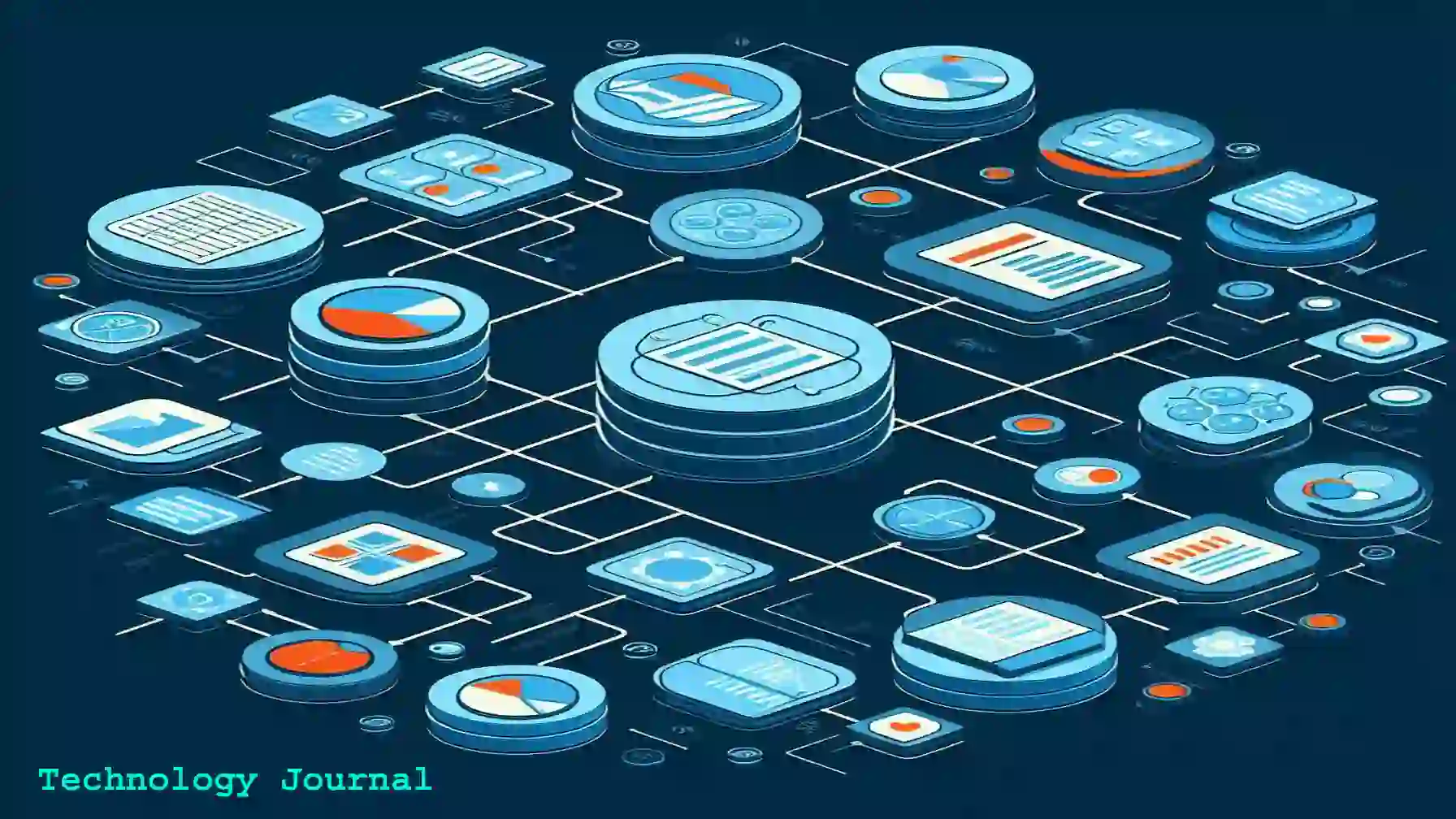In the ever-growing digital landscape, data has become the lifeblood of modern organizations. Businesses of all sizes rely on efficient information management to make informed decisions, optimize operations, and gain a competitive edge. Enter the world of Relational Database Management Systems (RDBMS), the unsung heroes behind the scenes.
RDBMS have been the cornerstone of data organization and retrieval for decades. These powerful systems allow for structured storage and manipulation of vast amounts of information. Imagine a library, but instead of bookshelves, you have meticulously organized tables filled with rows and columns. Each table represents a specific set of data, while rows and columns define individual entries and their attributes. This organized structure allows for efficient querying and retrieval of information, making RDBMS a critical tool for businesses of all sizes.
But RDBMS are more than just digital filing cabinets. They are intelligent systems that ensure data integrity and consistency. Concepts like primary keys, foreign keys, and constraints might sound technical, but they are the secret sauce that keeps your data accurate and reliable. Think of them as guardians within the database, ensuring that information is entered correctly and relationships between different data sets are maintained.
This blog post will take you on a fascinating journey into the world of RDBMS. We’ll delve into their history and evolution, explore the fundamental components that make them tick, and peek into the exciting future of relational databases. We’ll also explore practical applications and how RDBMS are used to manage real-world data. So, buckle up and get ready to unlock the secrets of RDBMS, the essential tools for navigating the ever-growing sea of information in today’s data-driven world!
Understanding the Role of RDBMS:
Relational Database Management Systems (RDBMS) play a crucial role in modern database management. Understanding the foundation of RDBMS involves delving into its history and evolution, tracing back to the 1970s with E.
F. Codd’s relational model concepts. This model forms the backbone of how data is organized and accessed in RDBMS.
Key components like keys, constraints, and transactions are vital aspects that ensure data integrity and consistency within a relational database. Operations and stored procedures allow for efficient data manipulation while maintaining security protocols.
Also Read: The Benefits of Using Object Oriented Programming in Your Projects
Normalization techniques help optimize database design by reducing redundancy, leading to better performance. Additionally, distributed RDBMS enables scaling across multiple servers for improved reliability and availability in large-scale applications.
The intricate workings of an RDBMS require a deep understanding of its functionalities to leverage its full potential in managing vast amounts of structured data effectively.
History and Evolution
In the realm of database management, understanding the history and evolution of Relational Database Management Systems (RDBMS) is crucial to grasp their significance in modern technology. The concept of RDBMS originated in the 1970s as a response to the limitations of hierarchical and network databases.
The pioneering work by Edgar Codd laid the foundation for the relational model, introducing concepts like tables, keys, and relationships that are fundamental to RDBMS today. Over time, with advancements in computing power and storage capabilities, RDBMS have evolved to handle vast amounts of data efficiently.
The evolution of RDBMS has been marked by innovations such as improved query optimization techniques, enhanced security features, and support for distributed environments. These developments have propelled RDBMS into being one of the most widely used database systems across various industries worldwide.
Relational Model Fundamentals
The relational model is the foundation of a relational database management system (RDBMS). It organizes data into tables, with each table consisting of rows and columns. Each row represents a record, while each column corresponds to a specific attribute.
Relationships between tables are established through keys, such as primary keys that uniquely identify each record and foreign keys that link records across tables. This structure allows for efficient storage and retrieval of information.
Normalization is a key concept in the relational model, ensuring data integrity by minimizing redundancy and dependency issues. By breaking down large tables into smaller ones and establishing relationships between them, normalization helps maintain consistency in the database.
The relational model’s simplicity and flexibility have made it popular in modern database management systems. Its ability to handle complex queries and support transactions makes it suitable for various applications across industries.
Key Components: Keys, Constraints, and Transactions
When working with a relational database management system (RDBMS), understanding key components like keys, constraints, and transactions is essential for ensuring data integrity and consistency.
Keys play a crucial role in uniquely identifying rows within tables. Primary keys enforce entity integrity by ensuring each record is distinct, while foreign keys establish relationships between tables to maintain referential integrity.
Constraints define rules that restrict the values allowed in columns, enforcing data accuracy and preventing inconsistencies. These can include unique constraints to ensure uniqueness or check constraints to validate data before insertion.
Transactions are vital for managing databases efficiently by grouping operations into atomic units of work. ACID properties (Atomicity, Consistency, Isolation, Durability) guarantee that transactions are executed reliably even in the event of failures.
Mastering these key components empowers database administrators to design robust systems that handle complex relationships and uphold data quality standards effectively.
Operations and Stored Procedures
When working with a Relational Database Management System (RDBMS), understanding operations and stored procedures is crucial.
Operations in RDBMS refer to the actions performed on data within the database, such as insert, update, delete, and select. These operations are fundamental for manipulating data effectively.
Stored Procedures are sets of SQL statements that are stored in the database and can be executed multiple times without re-writing code. They help improve efficiency by reducing network traffic and enhancing security through controlled access.
By using stored procedures, developers can streamline complex tasks, enhance performance, maintain consistency in data processing logic across applications, and ensure better security measures within the database environment.
In essence, mastering operations and utilizing stored procedures efficiently can significantly boost productivity when managing databases with RDBMS systems like MySQL or Oracle.
Normalization and Data Integrity
Normalization plays a crucial role in maintaining data integrity within a relational database management system (RDBMS). It involves organizing data to minimize redundancy and dependency, ensuring consistency and accuracy. By breaking down tables into smaller, related entities, normalization reduces the risk of anomalies that can compromise data quality.
The process of normalization follows specific forms – from First Normal Form (1NF) to Boyce-Codd Normal Form (BCNF), each addressing different aspects of data organization. By adhering to these normal forms, databases become more efficient and easier to maintain over time.
Data integrity is essential for reliability. RDBMS enforces constraints like Primary Keys, Foreign Keys, Unique Constraints, and Check Constraints to uphold the accuracy and consistency of stored information. This ensures that only valid data is entered into the database and maintains referential integrity between related tables.
Distributed RDBMS
Distributed RDBMS is a concept that involves spreading data across multiple servers to enhance performance and scalability. In this setup, data is partitioned and stored on different machines, allowing for faster access times and improved fault tolerance.
By distributing the database workload, distributed RDBMS systems can handle larger volumes of data and accommodate more users simultaneously without compromising speed or reliability. This architecture also supports geographically dispersed teams accessing the same database in real-time.
One key challenge of distributed RDBMS is ensuring data consistency across all nodes. Strategies like two-phase commit protocols are employed to maintain synchronization between distributed databases effectively.
Distributed RDBMS offers a robust solution for organizations needing to manage vast amounts of data efficiently while maintaining high availability and performance levels across varying locations.
Exploring RDBMS in Practice:
Exploring RDBMS in practice offers a hands-on experience into the world of managing relational databases efficiently. One common example is MySQL, a popular RDBMS known for its reliability and scalability. Its user-friendly interface makes it ideal for both beginners and experienced developers alike.
RDBMS comes equipped with essential features like data integrity enforcement through constraints, ensuring your database remains consistent and accurate. The use of keys helps establish relationships between tables, facilitating efficient data retrieval operations.
Understanding how RDBMS works involves grasping the concept of transactions that ensure ACID properties are maintained during data manipulations. Stored procedures allow for reusable code execution within the database itself, enhancing performance and security.
Comparing different RDBMS products can shed light on their unique histories and evolution over time. Each has its strengths and weaknesses based on specific needs, making it crucial to select one that aligns best with your project requirements.
MySQL as an Example
MySQL, a popular open-source relational database management system (RDBMS), has been a cornerstone in the tech industry for years. Known for its reliability and scalability, MySQL is widely used in various applications ranging from small websites to large enterprises. Its ease of use and strong community support make it a top choice for many developers.
One of MySQL’s key features is its flexibility in handling complex queries efficiently while maintaining data integrity. With support for multiple storage engines, including InnoDB and MyISAM, users can optimize performance based on their specific needs.
Moreover, MySQL offers robust security features such as user authentication and encryption to protect sensitive data from unauthorized access. Additionally, its seamless integration with programming languages like PHP and Python simplifies application development processes.
MySQL’s versatility and reliability have solidified its position as a leading RDBMS in the industry today.
Features of RDBMS
Relational Database Management Systems (RDBMS) offer a plethora of features that make them essential in modern database management. One key feature is data integrity, ensuring the accuracy and consistency of information stored within the database.
Another vital aspect is transaction management, allowing for atomicity, consistency, isolation, and durability (ACID properties). This ensures that complex operations are executed reliably without compromising data integrity.
RDBMS also provide robust security mechanisms to control access to databases and safeguard sensitive information from unauthorized users. Additionally, these systems support scalability by handling large volumes of data efficiently through indexing and query optimization techniques.
Furthermore, RDBMS facilitate data normalization to reduce redundancy and improve overall database performance. This process organizes data into logical tables while establishing relationships between them to enhance efficiency in retrieving and manipulating information.

Advantages and Uses
RDBMS offers various advantages that make it a popular choice for modern database management. One key advantage is its ability to establish relationships between different sets of data, ensuring data integrity and consistency. This relational structure allows for efficient querying and retrieval of information, enhancing overall performance.
Moreover, RDBMS provides robust security features to protect sensitive data from unauthorized access or modification. With the use of user privileges and access controls, organizations can ensure data confidentiality and compliance with regulations.
In addition, the structured query language (SQL) used in RDBMS enables users to easily interact with databases through standardized commands. This simplifies data manipulation tasks such as adding, updating, or deleting records without requiring complex programming knowledge.
The versatility of RDBMS extends beyond traditional business applications to various industries like healthcare, finance, e-commerce, and more. Its scalability makes it suitable for small businesses as well as large enterprises seeking a reliable solution for managing their growing volumes of data effectively.
How RDBMS Works?
When it comes to understanding how RDBMS works, it’s essential to dive into the core functionality of this database management system. RDBMS operates by storing data in tables where each table consists of rows and columns. These tables are related through keys, establishing relationships within the database.
Queries in RDBMS are executed using SQL (Structured Query Language), which allows users to interact with the database by inserting, updating, or retrieving data. The relational model ensures that data is stored logically without redundancy, maintaining consistency and integrity.
Transactions play a crucial role in ensuring that multiple operations on the database occur reliably and consistently. ACID properties (Atomicity, Consistency, Isolation, Durability) govern these transactions to guarantee data reliability even in case of system failures.
Comprehending how RDBMS functions provides insight into its robust structure and efficiency in managing complex datasets securely.
Product Comparisons and History
When it comes to comparing RDBMS products, historical context plays a crucial role in understanding the evolution of these databases. Various products like MySQL, PostgreSQL, Oracle Database, and SQL Server have left their mark on the database management landscape. Each product has its strengths and weaknesses based on factors like scalability, performance, and ease of use.
MySQL stands out as one of the most popular open-source RDBMS solutions known for its speed and reliability. On the other hand, PostgreSQL is renowned for its advanced features and strong support for complex queries. Oracle Database has been a dominant player in enterprise-level deployments due to its robustness and comprehensive feature set.
SQL Server from Microsoft offers seamless integration with other Microsoft products which makes it a preferred choice in Windows environments. Understanding the history and unique characteristics of each product can help businesses make informed decisions when selecting an RDBMS that best suits their specific needs.
The Future of Relational Databases:
As technology advances rapidly, the future of relational databases is evolving to meet new challenges. Developers are focusing on enhancing RDBMS capabilities to handle complex data requirements efficiently. Trends in RDBMS development show a shift towards scalability and flexibility, allowing for seamless integration with modern applications.
One exciting prospect is the emergence of self-driving databases that utilize AI technologies to optimize performance and automate routine tasks. These innovations aim to streamline database management processes and improve overall system reliability. Integrating AI into RDBMS opens up possibilities for predictive analytics and proactive maintenance strategies.
The advent of self-optimizing databases signifies a significant step forward in database management practices. By harnessing the power of artificial intelligence, relational databases can adapt dynamically to changing workloads and ensure optimal performance levels at all times. The future holds promising advancements as RDBMS continue to evolve alongside technological developments in the digital landscape.
Trends in RDBMS Development
In the ever-evolving world of database management, trends in RDBMS development play a crucial role in shaping the future of data storage and retrieval. One prominent trend is the focus on scalability and performance optimization to handle massive datasets efficiently.
Another key aspect is the integration of cloud technology, allowing for more flexible deployment options and improved accessibility. Security enhancements are also at the forefront, with increased emphasis on encryption methods and compliance standards to protect sensitive information.
Moreover, there is a growing interest in incorporating machine learning algorithms within RDBMS systems to automate tasks such as query optimization and data indexing. This trend towards AI integration aims to enhance decision-making processes and streamline database operations.
Furthermore, advancements in real-time analytics capabilities are becoming increasingly important, enabling organizations to make informed decisions based on up-to-date data insights. The ability to process streaming data efficiently is a significant focus area for RDBMS developers moving forward.
Self-Driving Databases and AI Integration
As technology advances, the integration of artificial intelligence (AI) into relational database management systems (RDBMS) is revolutionizing data handling. Self-driving databases are emerging as a game-changer in the industry. These intelligent systems can automatically optimize performance, tune configurations, and even predict potential issues before they occur.
By leveraging AI algorithms, self-driving databases can adapt to changing workloads and usage patterns in real-time. This automation reduces manual intervention requirements significantly, allowing database administrators to focus on more strategic tasks rather than routine maintenance.
You may also like to read: How RDBMS Technology is Revolutionizing Data Management in the Digital Age?
The combination of RDBMS with AI not only enhances operational efficiency but also improves decision-making processes by providing valuable insights from vast amounts of data. With machine learning capabilities embedded within the database system itself, organizations can unleash the full potential of their data assets while ensuring optimal performance and reliability.
Incorporating self-driving capabilities into RDBMS represents a significant leap forward in database management practices. The synergy between AI and traditional relational databases opens up new possibilities for businesses looking to stay competitive in today’s data-driven landscape.
Conclusion:
The role of RDBMS in modern database management is undeniable. With a rich history, solid fundamentals, and continuous evolution to meet the demands of today’s data-driven world, relational databases remain a cornerstone of information storage and retrieval.
As trends in RDBMS development continue to shape the landscape of data management, the integration of AI and self-driving capabilities points towards an exciting future for relational databases. These advancements will enhance efficiency, accuracy, and scalability in handling vast amounts of data across various industries.
While new technologies may emerge on the horizon, RDBMS continues to prove its relevance by adapting to changing needs and pushing boundaries in database management. Embracing innovation while staying true to its core principles ensures that relational databases will remain a vital tool for businesses looking to organize their data effectively and securely in the years ahead.








